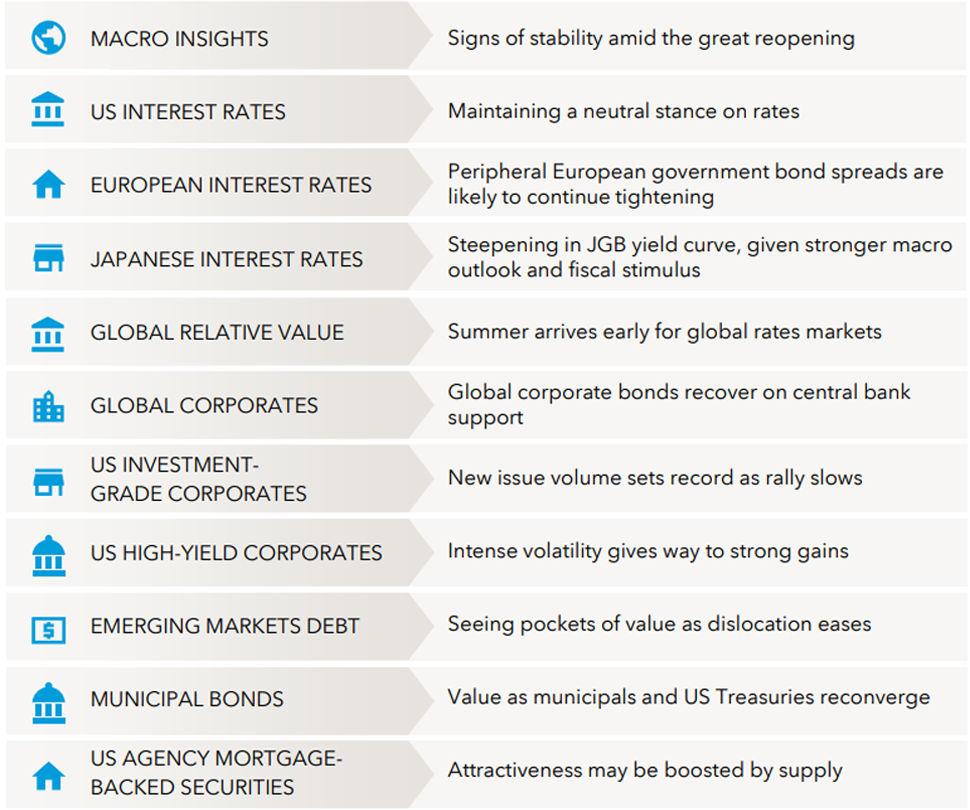Fixed Income
Bonds
Some signs of stability amid widespread efforts to reopen economies

The great reopening began as the US and other economies experimented with easing restrictions imposed in response to the COVID-19 pandemic. Recent data appeared to show a bottoming of economic activity in April. Some indicators improved substantially in May, commensurate with widespread relaxation of lockdown measures.
Despite recent signs of stabilisation, hopes for a V-shaped rebound are fading ― global recovery will likely be more gradual. Resurgent infection rates in some parts of the globe at a time when economic growth remains deeply negative suggest that the path of recovery will be bumpy.
US investors appeared to shrug off the rise in COVID-19 infections following the rollback of lockdown restrictions in many states. Actions by the US Federal Reserve (Fed) bolstered investor confidence that economic and financial collapse had been avoided. The Fed cut rates in March. Its balance sheet grew from nearly US$5 trillion in April to over US$7 trillion in June; already-announced programs could see its assets reach US$9 trillion.
It may be a long road to recovery
.png)
For illustrative purposes only. Sources: Bureau of Economic Analysis, Philadelphia Federal Reserve, RDQ Economics. Baseline projection shown from RDQ Economics as of June 2020. Trend based on 2.25% growth.
US Consumer spending fell at its fastest month-over-month pace in decades. Confidence among consumers also weakened significantly, as did the labour market. That said, money supply has increased dramatically. Economic Impact Payment cheques, extended unemployment benefits and an increase in personal savings have all contributed to record levels in both the M1 and M2 measures of money supply.
A major unknown for the economy is how cautious US consumers will be with their spending. Household savings that are drawn down and other excess liquidity may eventually lead to higher inflation. However, in the current period of economic contraction, high unemployment and weak consumption, we expect a disinflationary impulse to persist.
Business activity picked up from its recent lows, providing another sign of potential market stabilisation despite the uncertain outlook. The IHS Markit Composite PMI Output Index, which is based on survey data from both manufacturing and services, provided some positive news amid contracting global trade and export orders.
Business activity is rebounding
.png)
Source: IHS Markit; latest available data as of 30 June 2020.
Unemployment in the US reached an 80-year high of 14.7% in April, before modestly retreating as parts of the economy reopened. June’s unemployment rate was 11.1%1. This spike in unemployment significantly exceeded what was observed in the euro area and Japan ― a disparity that partly reflects structural differences in labour markets. For this reason, employment in the US could recover comparatively quickly. That said, if the resurgence of COVID-19 continues, unemployment rates in the hard-hit leisure, entertainment and food service industries may not ease so quickly.
US Unemployment has pulled back from an 80-year high
.png)
Sources: Refinitiv Datastream. Latest data available through June 2020.
The European Central Bank (ECB) lowered its growth projections. In June, the ECB announced it expects real GDP will recover only gradually toward precrisis levels, remaining below the level it previously projected through 2022. Talks on the European Union’s proposed recovery fund progressed, though details around its size and timing are yet to be hammered out.
Tension between the US and China reignited. In May, President Donald Trump’s administration announced it was considering options to confront China on its handling of the COVID-19 pandemic, including cutting off all relations. Meanwhile, several lawsuits centring on China’s handling of the pandemic were filed in US Federal courts. China threatened to retaliate ― against both the impending legal action and US restrictions imposed on Chinese telecom giant, Huawei.
Geopolitical tensions weighed on risk sentiment at times in the second quarter. This dynamic will likely continue in the run-up to the US presidential election in November.
We maintain a cautious view of markets, informed by weakening fundamentals and an uncertain economic trajectory. Currently, a prolonged recovery seems more likely than a sharp rebound. This outlook suggests many governments could decide to fund additional stimulus. Extension or renewal of existing monetary policy programs are also likely. In combination, fiscal and monetary efforts should, therefore, provide a significant backstop for liquidity and markets.
1. Source: U.S. Bureau of Labor Statistics
2. Source IHS Markit
3. Health and Economic Recovery Omnibus Emergency Solutions Act.
Risk factors you should consider before investing:
- This material is not intended to provide investment advice or be considered a personal recommendation.
- The value of investments and income from them can go down as well as up and you may lose some or all of your initial investment.
- Past results are not a guide to future results.
- If the currency in which you invest strengthens against the currency in which the underlying investments of the fund are made, the value of your investment will decrease.
- Depending on the strategy, risks may be associated with investing in fixed income, emerging markets and/or high-yield securities; emerging markets are volatile and may suffer from liquidity problems.
Our latest insights
Past results are not a guarantee of future results. The value of investments and income from them can go down as well as up and you may lose some or all of your initial investment. This information is not intended to provide investment, tax or other advice, or to be a solicitation to buy or sell any securities.
Statements attributed to an individual represent the opinions of that individual as of the date published and do not necessarily reflect the opinions of Capital Group or its affiliates. All information is as at the date indicated unless otherwise stated. Some information may have been obtained from third parties, and as such the reliability of that information is not guaranteed.